– The significance of the Allegheny woodrat in ecosystems and the challenges it faces
– The role of nest box cameras in wildlife conservation and research
– Insights gained from observing Allegheny woodrat behavior via nest box cameras
– The future of wildlife monitoring technologies and their impact on conservation efforts
The Allegheny woodrat, a species of conservation concern, plays a pivotal role in its ecosystem. As seed dispersers, these nocturnal rodents contribute to their habitat’s health and regeneration, ranging from the eastern United States forests to rocky outcrops. However, their populations are in decline due to habitat fragmentation, disease, and decreasing food sources. Addressing these challenges necessitates innovative approaches, among which the Allegheny woodrat nest box camera project stands out as a critical tool for conservationists and researchers.
Nest box cameras, as applied in wildlife conservation and research, offer a discreet means to study animal behavior, breeding cycles, and interaction with their environment. This technology allows for continuous monitoring without the need for physical presence, which can stress or alter the behavior of study subjects. In the case of the Allegheny woodrat, these cameras have provided a window into their secretive lives, offering insights vital for developing effective conservation strategies.
Observing Allegheny woodrat behavior through nest box cameras has yielded valuable data on their nesting habits, social interactions, and foraging behaviors. For instance, the cameras have captured critical moments such as the breeding practices of woodrats and the nurturing of their young, offering a comprehensive overview of their life cycle. Furthermore, they help identify woodrats’ food preferences and how they adapt to changing environmental conditions. This information is crucial for habitat management and restoration efforts, ensuring that conservation measures align with the species’ biological needs.
The future of wildlife monitoring technologies, with nest box cameras being a prime example, promises to revolutionize conservation efforts. Advances in camera technology, such as improved night vision, motion sensors, and data transmission capabilities, will provide even deeper insights into the lives of secluded or endangered species like the Allegheny woodrat. Moreover, the integration of artificial intelligence can enhance the analysis of collected data, enabling the identification of patterns and trends that may not be apparent to human observers. This can lead to proactive rather than reactive conservation measures, creating a more sustainable coexistence between human activities and wildlife.
As we forge ahead, deploying and improving nest box cameras and other monitoring technologies are critical for wildlife conservation. These tools help gather essential data for the protection of species like the Allegheny woodrat and foster a greater appreciation and understanding of the natural world. As awareness and scientific knowledge expand, so does the potential to mitigate the threats facing vulnerable populations, securing a healthier planet for future generations. Engaging with and supporting such technological advancements in conservation represents a significant step towards preserving biodiversity and ecosystem integrity in an increasingly anthropogenic landscape.
*****
Source Description
The Maryland Zoo, the Pennsylvania Game Commission, and the University of Pennsylvania School of Veterinary Medicine’s Wildlife Futures Program are members of the Allegheny Woodrat Working Group that have teamed up to start a Woodrat Captive Breeding Program to rebuild struggling populations of Allegheny woodrats.
Through the program, a small number of wild animals will form a founding colony at Maryland Zoo. The first such woodrat turned out to be pregnant and subsequently gave birth to three pups at the Zoo. Ultimately, she will be joined by woodrats from Virginia and Indiana to breed future generations.


